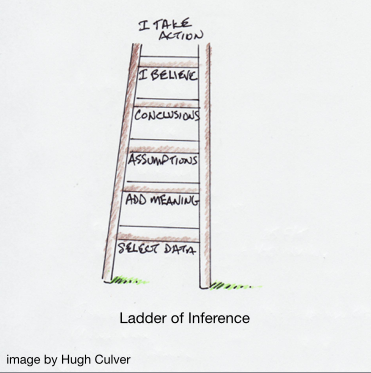How mental models help you think, teach, and change lives.
I can still remember, years ago, stumbling across a hand drawn diagram of a ladder that changed my thinking forever. It wasn’t just any ladder, it was Peter Senge’s Ladder of Inference model in his  remarkable book The Fifth Discipline: The Art and Practice of the Learning Organization.
remarkable book The Fifth Discipline: The Art and Practice of the Learning Organization.
Starting at the bottom, the rungs of the ladder were labeled “Observable data”, “Select data”, “Add meaning” all the way up to the top rung labeled “I take action based on my beliefs”.
It wasn’t that I didn’t know how perceptions influenced behaviour. I just hadn’t seen it presented in such a clear and physical way before. It was sticky.
Senge used models to uncoupled complicated concepts, like system thinking, and personal mastery. He made high-brow thinking palatable outside the ivory towers of academia. The challenge, as he put it, is "The world is made of Circles. And we think in straight Lines”
“The world is made of Circles. And we think in straight Lines” - Peter M. Senge
ENTER MENTAL MODELS
We’ve all seen the diagram of three circles that intersect in the middle. The intersecting space in the middle is different from it’s three parent areas. We learn that something was or could be created anew by marrying three unique things together. It’s called a Venn diagram. But, that’s not important. What’s important is it’s another example of how a mental model, like that, can help nudge our brains into thinking something new or understanding something complex.
Author (The Rational Imagination: How People Create Alternatives to Reality) and cognitive scientist, Ruth M.J.Byrne writes that models represent a “possibility.”
“Our mind is full of conflicting thoughts and Must Do’s - that’s where models come in. Models cut through all the confusion and challenge common thinking. Each mental model represents a possibility. Mental models are akin to architects’ models or to physicists’ diagrams in that their structure is analogous to the structure of the situation that they represent, unlike, say, the structure of logical forms used in formal rule theories.” - Ruth M.J.Byrne
POPULAR MODELS YOU CAN STEAL
Models are there for you to use (or steal if you want to feel really sneaky). Here are some that I have used to explain somewhat complicated concepts:
- Urgent vs. Important - the trick to effective use of time is to work on what is important before it becomes urgent (Covey)
- Effective Habits - intersection of: knowledge, desire, and skills (Covey)
- Circle of influence/Circle of concern - there is only so much we can each effect and there is always much more we can be concerned about (Covey)
- Start with Why - the core reason to do anything begins by understanding why it needs to be done (Sinek)
- Shared Vision - teams can evolve from “telling” to “Co-creating”
- The Learning Organization - this model was the heart of Senge’s Fifth Discipine book.
- Personal Mastery - is the combination of: Creative Tension (another model), Personal Vision, and Commitment to the truth (Senge).
- System Thinking - problem solving by viewing the problem as part of an overall system (like urban planning) (Senge).
- Creative Tension - (created by Robert Fritz) it is essential that people and organizations maintain some tension between what is and what is wanted.
MAKE YOUR OWN MODEL
The reality is you don’t have to have a Ph.D or lecture at MIT, as Senge does, to use and even create models.
“The mind constructs ‘small-scale models’ of reality that it uses to anticipate events, to reason, and to underlie explanation.” - Scottish psychologist Kenneth Craik
You can use mental models in coaching, teaching, sales, even showing your child how the conscious and subconscious brains collaborate (Iceberg Theory - many facts and assumptions reside “below the surface” of our consciousness).
My Think, Plan, Act model was birthed out of my keynotes and a need to galvanize my speech into a central theme. Once I realized I was employing a very similar logical flow to all my keynotes (think differently, plan better, take action now) I simply documented it and started to refine it into a model.
Small Wins - Why Little Steps are the Path to Big Rewards
Keynotes and workshops by Hugh Culver


